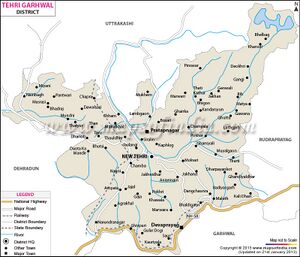Tehri Garhwal
| Author:Laxman Burdak, IFS (R) |
- For the town see Tehri

Tehri Garhwal (टिहरी गढ़वाल) is a district in Uttarakhand, India. Its administrative headquarters is at New Tehri Town.[1]
Variants
- Kedarakhanda (केदारखंड) (AS, p.223)
- Uragama (उरगम) (जिला गढ़वाल, उ.प्र.) (AS, p.100)
Location
It is surrounded by Rudraprayag District in the east, Dehradun District in the west, Uttarkashi District in the north, and Pauri Garhwal District in the south.
Origin
The name Tehri has been derived from Trihari, signifying a place that washes away the three types of sins – sins born out of Mansa, Vacha and Karmana or thought, word and deed, respectively. Garh in Hindi means fort.
History
Early History: Prior to 888 AD, the region was divided into 52 garhs which were ruled by independent kings. These garhs were brought into one province by Kanakpal, the prince of Malwa. Kanakpal, on his visit to Badrinath, had met the then mightiest king Bhanu Pratap who later married his only daughter to the prince and handed over his kingdom to him. Kanakpal Singh and his descendants gradually conquered all the garhs and ruled the whole of Garhwal Kingdom for the next 915 years, up to 1803.
Garhwal Kingdom: Tehri Garhwal[2] or Garhwal Kingdom, was a princely state, ruled by the Parmar (Shah) dynasty. Later, it became a part of the Punjab Hill States Agency of British India, which consists of the present day Tehri Garhwal District and most of the Uttarkashi district. In 1901, it had an area of about 4,180 square miles (10,800 km2) and a population of 268,885. The ruler was given the title of raja, but after 1913, he was honoured with the title of Maharaja. The ruler was entitled to salutes of 11 guns and had a privy purse of rupees 300,000. The princely state acceded to India on 1 August 1949.
Gorkha Rule: Gorkhas were expanding their kingdom. Gorkhas Started invading and occupying on other Kingdoms. In 1803, the Gorkhas invaded over Garhwal.[3] The Gorkha army generals Subba Amar Singh, Hastidal Chautariya, Bamshah Chautariya and Ranjor Thapa commanded a huge army in the crusade against King Pradyumna Shah and his sons Kunwar Parakrama Shah and Kunwar Pritam Shah. Garhwal Army fought with the Gorkhas at Khurhbure where the Garhwal king was killed. Gradually, the Gorkhas occupied Dehradun, Saharanpur, Kangada and Shimla and later on extended their kingdom up to Kangra.
From 1787 to 1812, the Gorkhas invaded and occupied nearly 200 villages which were under the control of the East India Company. The British argued with the king of Nepal but to no avail. Finally, the Gurkha War (Anglo-Nepalese War) began in 1814, when an army of 8,000 under Major General Marley attacked Kathmandu. Four thousand soldiers under Major General Wood started an operation from Gorakhpur and 3,500 soldiers attempted to take over Dehradun under Major General Zileswy. Finally, the British army captured Dehradun on 30 November 1814.
The British Army then moved towards Kumaon. After a fierce battle, the Gorkha commanders Hastidal and Jayrakha were killed at Vinayathal. The war ended with the Sugauli Treaty, signed on 2 December 1815 and ratified on 4 March 1816 by Gorkha supreme commander Bamshah and thus, British rule started in the hills. The East India Company then merged Kumaon, Dehradun and east Garhwal into the British Empire while west Garhwal was given Back to Sudarshan Shah which then became known as Tehri Riyasat.
New capital: King Sudarshan Shah established his capital at Tehri town and afterwards his successors Pratap Shah, Kirti Shah and Narendra Shah established their capital at Pratap Nagar, Kirtinagar and Narendra Nagar, respectively. Their dynasty ruled over this region from 1815 to 1949. During the Quit India Movement people of this region actively worked for the independence of the country. Ultimately, when the country was declared independent in 1947, the inhabitants of Tehri Riyasat (Tehri State) started their movement to free themselves from the clutches of the maharaja.
Due to this movement, the situation became out of his control and it was difficult for him to rule over the region. Consequently, the 60th king of Pawar Vansh, Manvendra Shah, accepted the sovereignty of the Indian government. Thus, in August 1949, Tehri Riyasat was merged into Uttar Pradesh and was given the status of a new district, the Rudraprayag district. Subsequently, on 24 February 1960, the state government separated its one tehsil which was given the status of a separate district named Uttarkashi. Former royal palace of the Maharaja of Tehri Garhwal at Narendra Nagar, now houses the Ananda–In the Himalayas spa, established 2000.[4]
केदारखंड
विजयेन्द्र कुमार माथुर[5] ने लेख किया है ...केदारखंड (AS, p.223) उत्तराखंड राज्य के टिहरी गढ़वाल का प्राचीन पौराणिक नाम है. केदारनाथ यहीं स्थित है.
उरगम
विजयेन्द्र कुमार माथुर[6] ने लेख किया है ...उरगम (AS, p.100) उत्तराखंड राज्य के टिहरी गढ़वाल ज़िले में स्थित था। प्राचीन गढ़वाली नरेशों के बनवाए प्राचीन मंदिर ध्वंसावशेषों के लिए यह स्थान उल्लेखनीय है।
External links
References
- ↑ http://tehri.nic.in/pages/display/54-location-and-area#
- ↑ Tehri Garhwal The Imperial Gazetteer of India, 1909, v. 23, p. 269.
- ↑ Chisholm, Hugh, ed. (1911). "Garhwal" . Encyclopædia Britannica. 11 (11th ed.). Cambridge University Press. p. 466.
- ↑ Himalayan Spa for Sybarites By CELIA W. DUGGER. New York Times. July 30, 2000.
- ↑ Aitihasik Sthanavali by Vijayendra Kumar Mathur, p.223
- ↑ Aitihasik Sthanavali by Vijayendra Kumar Mathur, p.100

